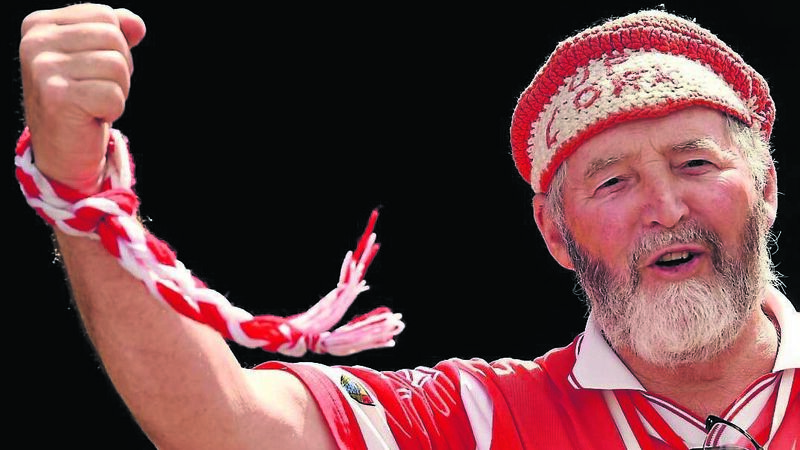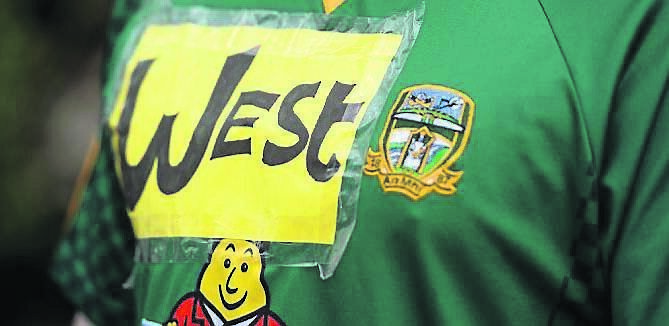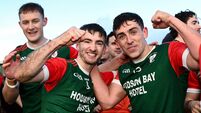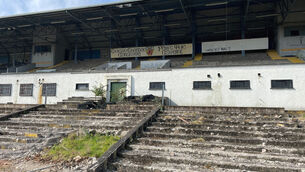Paul Rouse: When pride in your county became a fashion accessory

The obvious attraction for the public is clear. Boundaries between counties are sacred lines in Irish life, writes Paul Rouse
I have a relation who spent much of his 20s in an Offaly jersey whose colours were green, Guinness and gold.
This was the 1990s, days when Offaly people spent almost as much time in Croke Park as they did in their native parishes.
It was considered a controversial decision for a grown man but my relation sometimes also went around Dublin dressed in the full replica kit, naturally with the socks pulled up to the knees.
And fortunately he didn’t restrict this outfit to match days; this would have denied the wider public the opportunity to experience something truly unique.
Despite the taunts from those less fortunate than himself, he carried himself with great dignity.
Indeed, in many respects, he was something of a pioneer; it might even be said that he was a trendsetter, an influencer before there were influencers. Because during that decade, the 1990s, replica GAA jerseys moved to the mainstream of fashion in Ireland.
The arrival of sponsors and the mass production of adult jerseys for sale as leisurewear brought new designs, new cuts, new styles, new material.
My relation is a purist (of sorts and only in very particular things and definitely only when it suits him); accordingly, he resisted all suggestions that he retire his jersey in favour of any newer model.
He stopped wearing his jersey when it became apparent that everyone else was wearing ones of their own. Like Alexander the Great, he was disillusioned at having no known worlds left to conquer, and duly retired.
The final straw was seeing Kildare play Galway in the 1998 All-Ireland football final. Croke Park was filled with men, women, and children sitting proudly in their Persil-bright Lilywhite jerseys. There were also many others there in the maroon of Galway, of course, but it was the white which stood out on TV with extraordinary vividness. It was as if large sections of the stands were waiting to be skied down.
How had this happened? How was it that adult replica jerseys were now ubiquitous at GAA matches, where once those matches were where men and women wore their Sunday best?
More than that, how was it that wearing county jerseys became such a phenomenon at all manner of public events during the 1990s? To give one example: if you look at the footage of the 1990 Féile festival in Thurles, GAA jerseys are most notable by their absence. Take a leap forward to the Witnness music festival in 2000 at the Fairyhouse racecourse and GAA jerseys were everywhere.

Newly modelled jerseys were subsequently supplemented by a whole range of retro jerseys, sold on various websites, along with t-shirts, training tops, tracksuits, polo shorts, fleeces, hats, raingear, all carrying the badges of county loyalty.
The obvious attraction for the public is clear. Boundaries between counties are sacred lines in Irish life. But walking around the place wearing a crepe paper hat and a rosette in county colours was not something that people ordinarily wished to do at work or on the town.
With GAA merchandising from the 1990s, there was now a clear-cut way — for the first time — of wearing clothes that were an unambiguous way of expressing county identity.
In all of this, it is the arrival of the adult replica jersey that is of most interest. For the GAA, it is of course tied with in with a dramatic increase in the commercialisation of the games in the 1990s. The decision of the GAA to allow counties put sponsors’ names on the front of jerseys in mid-1990s, brought deals worth a lot of money to counties. It made sense for the finances of the jersey-makers and GAA county boards that the sale of these jerseys should be pursued as widely as possible. The greatly enhanced media presentation of the GAA through the broadcast of live matches and the marketing wizardry of new title sponsors of the All-Ireland championships lent further and significant impetus to this whole process.
But the wider context is also important. The evolution of replica jerseys from something that was the preserve of children to something for adults that was first acceptable and then desirable was not an Irish phenomenon.
It was, instead, something that had become commonplace in America and then in Britain. The wearing of soccer jerseys in England is a case in point. Slowly, insistently — and then rapidly, replica jerseys had come by the early 1990s to offer a vital financial income for English soccer clubs. Putting sponsorship on shirts in England was actually pioneered by the non-league team, Kettering Town. On 24 January 1976, Kettering played Bath City in a Southern League Premier Division match against Bath City, wearing jerseys featuring the logo of their sponsors, Kettering Tyres.
After a dispute with the English FA, they were followed by Liverpool, the first club in England’s top division to carry sponsorship, when they put Hitachi on their jerseys in 1979 shirts. The innovation was subsequently taken on by all the major soccer clubs in England who understood the potential of the jersey as a means to earn money from the sponsor, and also as a way to sell additional replica merchandise.
It is true replica kits for children had been sold from the 1950s in a limited way. This expanded in the 1960s as TV coverage of the game grew in the 1960s and 1970s, but it was in the 1980s and the 1990s that it truly exploded.
The manner and timing of the adoption by adults of soccer jerseys as leisurewear was examined last year in work by the English academics, Christopher Stride, Nick Catley, and Joe Headland.
They wrote: “The replica shirt has become a match-day uniform, a totem of football’s cultural hegemony — and symbolic of the all-enveloping consumerism of society: even traditionalists who decry the multi-sponsored, highly-priced current first-team strip will display their authenticity via retro-replica shirts.”
And they explained that this started happening in England in the late 1970s, when Admiral began selling North American Soccer League jerseys in England. It was also noted that a few adult fans began to get their hands on replica jerseys of their teams in the 1970s, also.
During the 1980s, jersey manufacturers then began to expand the range of jerseys sold to adults. These were only aimed at men — women’s cuts were only a product of the 1990s.
As the 1980s turned to the 1990s, manufacturers began to market their adult jerseys in a systematic way. Many of these adults had previously worn replica jerseys as kids and it was at these young male adults that marketing was targeted.
This process dramatically accelerated with the arrival of the Premier League in 1992 and the hyper-commercialisation that was now unleashed.
In wider society, the casualisation of the dress that people wore in everyday life was also accelerating; the day of the shirt-and-tie was dwindling in many arenas.
The timing of all of this was vital. Soccer became more fashionable again in England in the 1990s; indeed, a new, more middle-class soccer culture was forged. It all conspired to make the wearing of a replica shirt more acceptable.
It also brought a change in short design. This was the case not just in terms of colours and imagery, but also for size. As Stride, Catley and Headland wrote: “The increase in larger replica shirt sizes offered after 1992 catered for the middle-aged fan with accompanying middle-aged spread and less likelihood of wearing their shirt for any athletic purpose.”
The final transition in this process saw retailers stock replica shirts in huge numbers on the high street from the mid-1990s. It was both evidence and impetus for the centrality of soccer in English popular culture.
What happened in Ireland with GAA jerseys was a peculiarly Irish spin on this wider merchandising story.
And it helps explain how my relation came to inhabit a jersey which grew a history of its own. The last time the green, Guinness, and gold was worn was the day when Offaly beat Kilkenny in the 1998 All-Ireland hurling final.
It still bore the grass stains of heroism from the mass civil rights protest by Offaly supporters on the field in Croke Park after the tyrannous oppression suffered in that year’s Clare semi-final first replay.
Some lads sat down on the field that day by way of protest; my relative lay down peacefully and rested.
The jersey now rests at a secure location, a sacred relic, it was a piece of cloth perfect unto its time.








